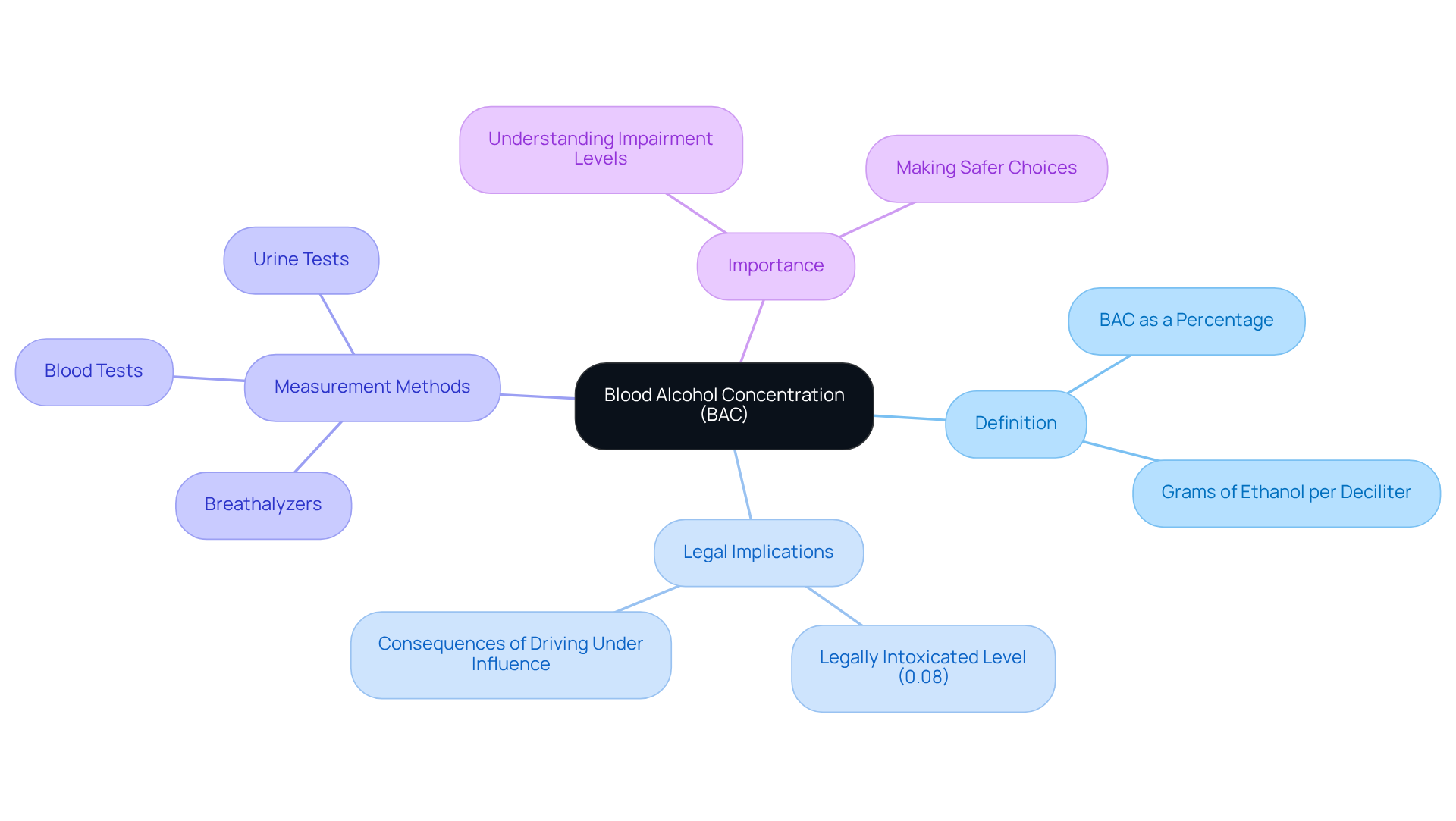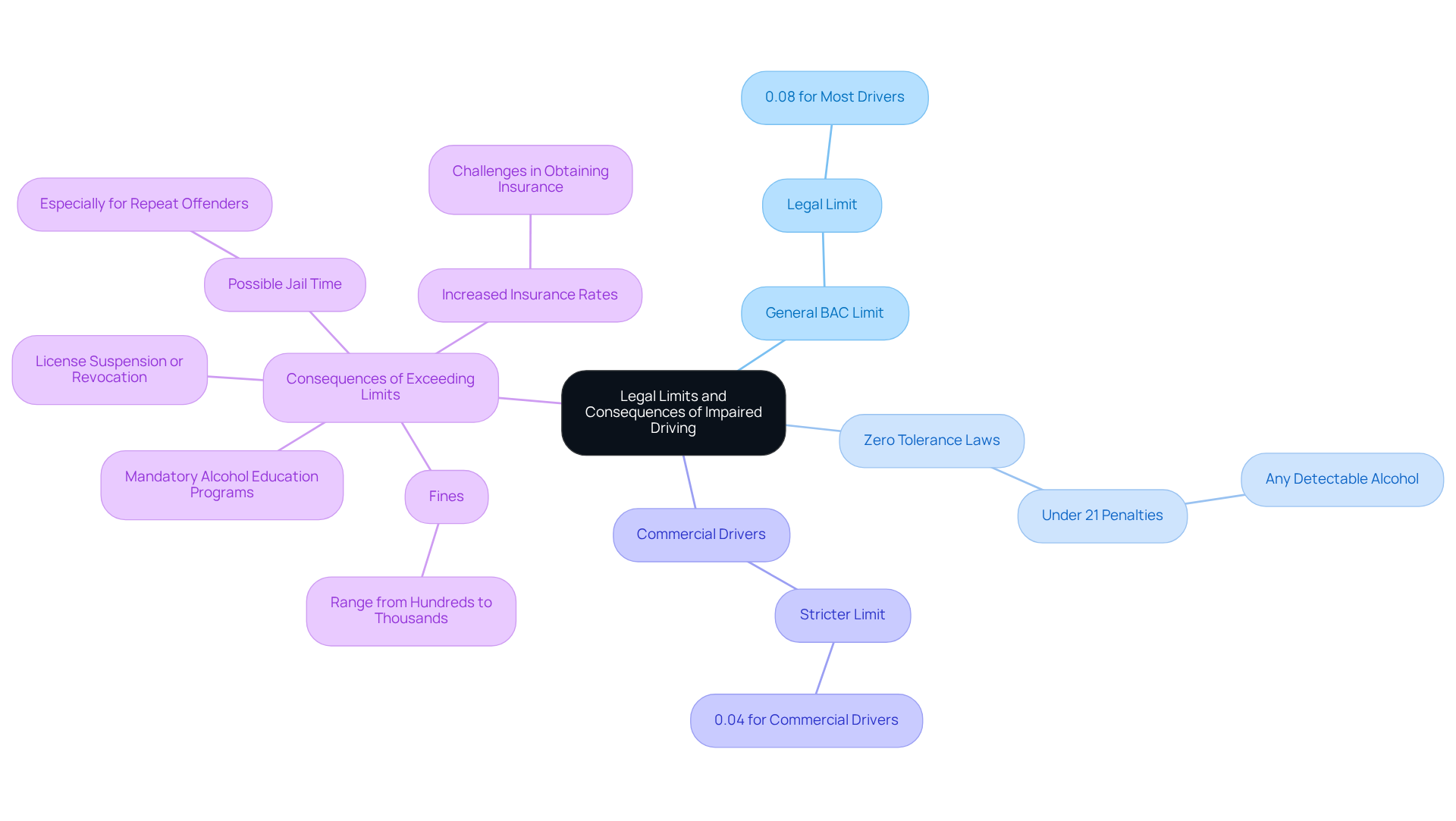Overview
Have you ever wondered about the legal limit for Blood Alcohol Concentration (BAC) while driving? In most states, it’s set at 0.08%. This typically means that an average adult might reach this limit after consuming about two standard beers, though individual factors can vary.
Understanding BAC is crucial. Exceeding this limit can lead to serious consequences—fines, license suspension, or even jail time. It’s important to know the risks involved and how they can impact your life.
We’re here to help you navigate these challenges. Remember, you’re not alone in this fight. Stay informed and make choices that protect your rights and your future.
Introduction
Understanding the legal limits around alcohol consumption and driving is vital for keeping our roads safe. Blood Alcohol Concentration (BAC) is a key measure that shows how much alcohol is in a person’s bloodstream. Knowing what this means can really influence your choices.
With the legal limit usually set at a BAC of 0.08%, many people wonder: how many beers can I have before I hit that mark? This article dives into the details of BAC, the factors that affect it, and the serious consequences of going over the legal limit. Our goal is to empower you to make informed decisions about drinking and driving.
Understand Blood Alcohol Concentration (BAC)
Blood Alcohol Concentration (BAC) is more than just a number; it’s a crucial indicator of how much alcohol is in your bloodstream. Expressed as a percentage, it tells you the grams of ethanol per deciliter of blood. For instance, a BAC of 0.08% means there are 0.08 grams of alcohol for every 100 milliliters of blood. Understanding BAC is vital because it directly relates to how impaired you might be and how many beers is the legal limit for driving.
Have you ever wondered what that means for you? In most states, how many beers is the legal limit equates to a BAC of 0.08% or higher, which is considered legally intoxicated. This can lead to serious legal consequences if you’re caught driving under the influence. It’s important to know that there are various ways to measure BAC, including:
- breathalyzers
- blood tests
- urine tests
We understand how overwhelming this can feel. But you don’t have to navigate this alone. Knowing your BAC can empower you to make safer choices and protect your rights. Remember, we’re here to fight for you and your family.

Identify Factors Affecting BAC Levels
Several factors can influence your blood alcohol concentration (BAC), and understanding them is crucial for making safe choices.
- Body Weight: If you weigh more, you generally have a lower BAC after drinking the same amount of alcohol compared to someone lighter.
- Gender: Women often show a higher BAC than men after consuming the same quantity of beverages, thanks to differences in body composition and metabolism.
- Rate of Consumption: Drinking spirits quickly can spike your BAC more than sipping the same amount over a longer time.
- Food Intake: Eating before or while drinking can slow down how quickly alcohol is absorbed, leading to a lower BAC.
- Beverage Content: The type of drink matters too—beer, wine, or liquor all have different levels of ethanol, affecting your BAC.
By grasping these factors, you can better assess your own tolerance and make informed decisions about drinking and driving. Remember, you’re not alone in this; we’re here to support you in navigating these choices.

Calculate Safe Beer Consumption for Driving
To calculate safe beer consumption, follow these essential steps:
- Know Your Weight: Your body weight plays a crucial role in determining your blood alcohol concentration (BAC). Use a BAC calculator or chart to estimate your BAC based on your weight.
- Understand Standard Drink Sizes: A standard drink is generally defined as:
- 12 ounces of beer (about 5% alcohol content)
- 5 ounces of wine (about 12% alcohol content)
- 1.5 ounces of distilled spirits (about 40% alcohol content)
- Estimate your limit by considering how many beers is the legal limit; for most people, sticking to one standard drink per hour can help keep BAC levels below 0.08%. Keep in mind, though, that individual factors can affect this.
- Use a BAC Calculator: Online BAC calculators are handy tools. Input your weight, the number of drinks consumed, and the time elapsed to get an accurate estimate of your BAC.
- Monitor Your Condition: Always check in with how you feel. If you sense any impairment, it’s best to avoid driving, no matter what your calculated BAC says.
By following these steps, you can better manage your drinking and stay within safe limits. Remember, you’re not alone in this—taking control of your consumption is a step toward responsible choices.

Recognize Legal Limits and Consequences of Impaired Driving
In most states, it's important to know how many beers is the legal limit for Blood Alcohol Concentration (BAC) while driving, which is 0.08%. But there’s more to consider:
- Zero Tolerance Laws: If you’re under 21, many states enforce zero tolerance laws. This means any detectable alcohol can lead to serious penalties.
- Commercial Drivers: For those behind the wheel of commercial vehicles, the limit is often stricter, usually set at 0.04%.
- Consequences of Exceeding Limits: Driving with a BAC over the legal limit can lead to harsh penalties, including:
- Fines that can range from hundreds to thousands of dollars
- License suspension or revocation
- Mandatory alcohol education programs
- Possible jail time, especially for repeat offenders
- Increased insurance rates or challenges in obtaining insurance
Understanding these legal limits and their consequences is crucial for making informed choices about drinking and driving. Always prioritize safety—if you plan to drink, consider alternative transportation options.
If you find yourself facing DUI charges or related offenses, know that Vasquez Law Firm is here to help. We offer comprehensive criminal defense services, including strong representation for DUI, drug crimes, assault charges, and domestic violence. Our bilingual legal team is available 24/7 to provide emergency support and guide you through these challenging times. Remember, you’re not alone in this fight.

Conclusion
Understanding Blood Alcohol Concentration (BAC) is crucial for anyone who drinks and plans to drive. The legal limit in most states is a BAC of 0.08%. This level indicates impairment that can lead to serious legal consequences. By being informed about BAC and its effects on driving, you can make safer choices and protect yourself from the dangers of impaired driving.
Key factors influencing BAC include:
- Body weight
- Gender
- Rate of consumption
- Food intake
- Type of beverage consumed
Recognizing these elements helps you gauge your limits and make informed decisions about your drinking habits. Additionally, calculating safe beer consumption means understanding standard drink sizes and using tools like BAC calculators to estimate your blood alcohol concentration accurately.
Ultimately, prioritizing safety and understanding the legal implications of drinking and driving are vital. Knowing the legal limits and the consequences of exceeding them—like fines, license suspension, and potential jail time—can make a difference. Always consider responsible drinking practices and alternative transportation options to ensure safety on the roads. By staying informed and making responsible choices, you contribute to a safer community for everyone. Remember, your choices matter, and together, we can create a safer environment.
Frequently Asked Questions
What is Blood Alcohol Concentration (BAC)?
Blood Alcohol Concentration (BAC) is a measure of the amount of alcohol in your bloodstream, expressed as a percentage indicating the grams of ethanol per deciliter of blood.
What does a BAC of 0.08% mean?
A BAC of 0.08% means there are 0.08 grams of alcohol for every 100 milliliters of blood, and it is the legal limit for driving in most states.
Why is understanding BAC important?
Understanding BAC is important because it relates directly to how impaired you might be and the legal consequences of driving under the influence.
What are the methods used to measure BAC?
BAC can be measured using breathalyzers, blood tests, and urine tests.
How can knowing your BAC help you?
Knowing your BAC can empower you to make safer choices regarding alcohol consumption and protect your rights.




